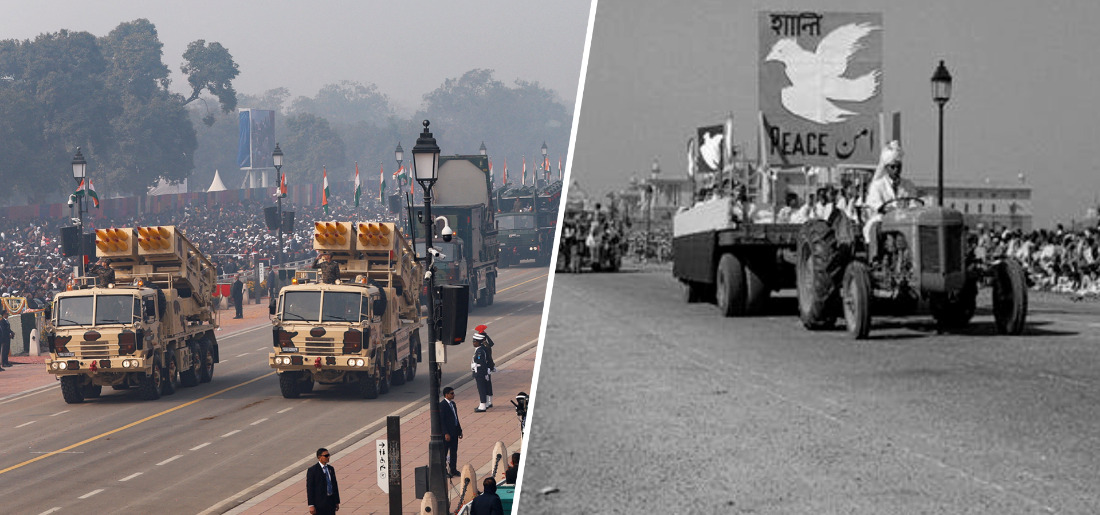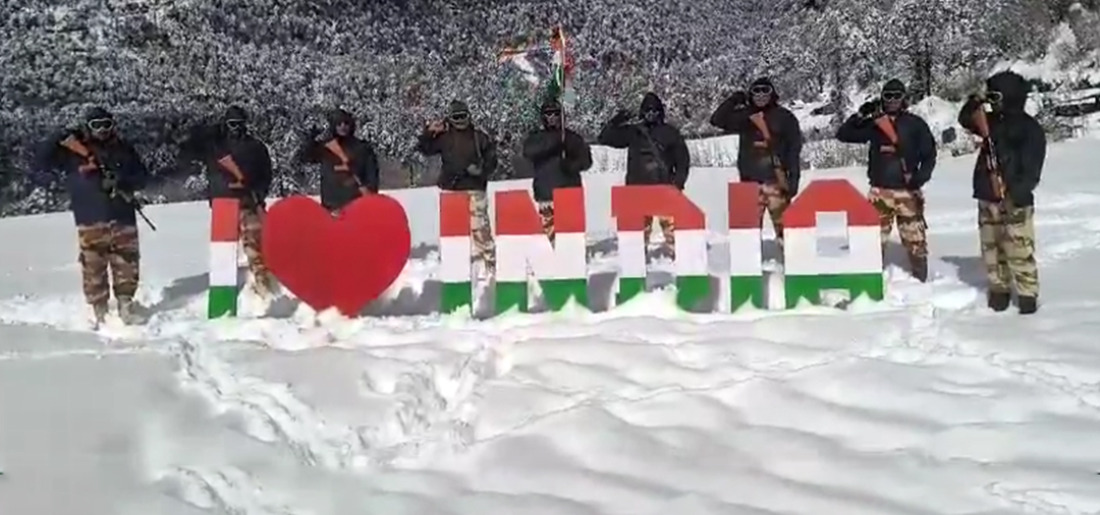 Frontlines | ??0Updated 6 years ago
Frontlines | ??0Updated 6 years ago Season 3, Episode 2: Hiding In Plain Sight
The biggest asset any army has is eyes and ears inside the enemy camp. These recce teams bring back essential information that becomes useful in war. This is the story of those who remain hidden in plain sight. And this is how close you'll get to an actual war.
Experience India's remarkable strides in defense prowess and self-reliance showcased at the 'Bharat Shakti' exercise in Pokhran, attended by PM Modi. Demonstrating the 'shock and awe' impact of the Indian armed forces, the event highlighted indigenous defense equipment like LCA Tejas, ALH Mk-IV, and T90 tanks. With a focus on Make in India, India now exports defense equipment to over 85 countries, doubling defense production in the last decade to over ?1 lakh crore. #BharatShakti #DefenseProwess #MakeInIndia ???
The 'Bharat Shakti' exercise in Pokhran showcased India's defense prowess, featuring indigenous weapons and equipment like LCA Tejas, ALH Mk-IV, and T90 tanks. PM Modi, along with delegates from 30+ countries, witnessed the event, highlighting the success of Make in India. This demonstration underscored India's self-reliance, self-confidence, and self-pride in its defense capabilities, including indigenous fighter aircraft, helicopters, and missile systems, reaffirming Pokhran's historical significance in India's nuclear and defense narrative.
In a historic 75th Republic Day celebration, India witnessed a remarkable display of 'Nari Shakti' as women took center stage. Notably, the all-women Tri-Services contingent proudly marched, alongside the BSF Mahila Brass Band and Border Security Force contingent, depicting feminine strength. Squadron Leader Rashmi Thakur led the Indian Air Force marching contingent, while the Delhi Police presented an all-women pipe band. Major Srishti Khullar led the Armed Forces Medical Services contingent on Kartavya Path, highlighting the collective empowerment of women in the country's security forces through bravery and determination.
In a groundbreaking display of Nari Shakti, female personnel from CRPF, BSF, and SSB showcased their courage and skill by performing daring motorcycle stunts during the Republic Day Parade. For the first time, these women demonstrated exceptional prowess, embodying strength and resilience. The spectacle not only celebrated their individual accomplishments but also symbolized the collective empowerment of women in the country's security forces, adding a remarkable and inspiring chapter to the Republic Day festivities.
The Republic Day Parade in India, from 1952 to 2024, has evolved into a grand spectacle. In 1952, it was a modest event with a focus on military prowess. Over the years, it transformed into a vibrant showcase of India's diverse culture, military might, and technological advancements. The inclusion of cultural floats, state-of-the-art weaponry, and impressive tableaux now reflects India's multifaceted progress. The parade remains a symbol of national pride, blending tradition with modernity.
Despite facing -40-degree temperatures, the morale remains high among ITBP (Indo-Tibetan Border Police) jawans. Braving the extreme cold in the snow-covered regions along the India-China border, these dedicated Himveers, entrusted with guarding the nation's remote boundaries, actively participated in the Republic Day celebrations, commemorating the 75th year of the Republic. Their unwavering commitment and resilience in such harsh conditions underscore the dedication of these brave soldiers to their duty, even in the harshest environments.
The Attari-Wagah Border, a historic crossroads, epitomizes resilience and unity. Once a bustling trade hub linking Lahore and Amritsar, it transformed post-partition. Guarded by the Indian Army since 1947, the joint check post witnessed its inaugural flag hoisting on October 11, 1947. The Punjab Police later assumed control, introducing the iconic retreat ceremony in 1952. Today, the Beating Retreat ceremony at Attari-Wagah continues as a global spectacle, symbolizing enduring camaraderie and mutual respect, a testament to hope and harmony prevailing amid historical challenges.
The naval variant of the BrahMos supersonic cruise missile, with an extended range of 350 to 400-km, and the indigenous man-portable anti-tank guided missile, with a 2.5-km strike range, were successfully tested on Tuesday.
The biggest asset any army has is eyes and ears inside the enemy camp. These recce teams bring back essential information that becomes useful in war. This is the story of those who remain hidden in plain sight. And this is how close you'll get to an actual war.
"Either I will come back after hoisting the Tricolour, or I will come back wrapped in it. But I will be back for sure," said Captain Vikram Batra, Param Vir Chakra awardee, Kargil War.On #ArmyDay, here's an inside look at how the Indian Army trains to stay fighting fit. On the base of the Naga hills, a battalion is ready to move in and capture an enemy bunker. This is as close as you will get to an actual war.
 IT Explains ? 6 months agoWhat sets Jewar Airport apart?
IT Explains ? 6 months agoWhat sets Jewar Airport apart?Noida International Airport welcomed its first flight, marking a key milestone ahead of its commercial launch in April 2025. An IndiGo flight, with crew and staff from the Airports Authority of India (AAI), successfully conducted the validation test, departing from Delhi¡¯s Indira Gandhi International Airport and landing in Jewar, Uttar Pradesh. The arrival was celebrated with a ceremonial water salute. Set to be Asia¡¯s largest airport, Noida International Airport is designed to handle 65 flights daily and aims to achieve net zero emissions, setting a new standard for sustainable airport operations. Developed across 1,344 hectares with a ?29,650 crore investment, the airport is expected to serve 1.2 crore passengers annually in its first phase. The test examined runway performance, airspace coordination, communication protocols, and emergency response readiness. The runway, designed with Zurich Airport Authority of Switzerland, spans approximately 3.9 km.
 IT Explains ? 1 year ago5 Things you must do when visiting Rajouri Market for the first time
IT Explains ? 1 year ago5 Things you must do when visiting Rajouri Market for the first timeWe went to Rajouri Garden, one of the most popular markets in Delhi and these are our top 5 coolest picks. From legendary eating joints to amazing shops, from Chole Bhature to Kulfi and footwear to sarees, we went all out!
 IT Explains ? 1 year agoFor The First Time Orangutan Recorded Treating Its Wound Just Like A Doctor
IT Explains ? 1 year agoFor The First Time Orangutan Recorded Treating Its Wound Just Like A DoctorIn a groundbreaking observation, researchers witnessed a male Sumatran orangutan named Rakus displaying remarkable self-healing behavior. After sustaining a facial wound, Rakus ingeniously used the anti-inflammatory and pain-relieving properties of Akar Kuning leaves to treat himself. Chewing the leaves and applying the juice directly to the wound, he repeated the process until the wound healed, leaving only a small scar. This behavior, unprecedented in wild animals, suggests a level of intentional medicinal plant use previously unseen in non-human primates.
 IT Explains ? 1 year agoFrom Harvard's Film School to Leading a Business Empire
IT Explains ? 1 year agoFrom Harvard's Film School to Leading a Business EmpireAnand Mahindra, born in 1955 into a prestigious Mumbai family, could have been a filmmaker but pursued a different path, studying filmmaking and photography at Harvard University. Now chairman of the Mahindra Group, he's known for his strong social media presence, sharing entrepreneurial insights and celebrating Indian innovation, like buying a house for the viral 'Idli Amma' and offering a job to a quadruple amputee. Mahindra sees social media as vital for 21st-century CEOs, using it to highlight grassroots innovations and extend helping hands.
 IT Explains ? 1 year agoNestle exploiting loophole in Indian baby food regulation?
IT Explains ? 1 year agoNestle exploiting loophole in Indian baby food regulation?Nestl¨¦ faces scrutiny for adding high levels of sugar to Cerelac baby formula in India, averaging 3 grams per serving, while selling the same product without added sugar in Europe and the UK. This practice, criticized by experts as dangerous and addictive, exploits a loophole in Indian regulations that lack specific limits on added sugars in baby food. Nestl¨¦ defends its actions, citing compliance with local laws, but critics argue this approach raises ethical and public health concerns, urging stricter enforcement and global standards.
 IT Explains ? 1 year agoKatchatheevu island row: The Island India ¡®gave away¡¯ to Sri Lanka
IT Explains ? 1 year agoKatchatheevu island row: The Island India ¡®gave away¡¯ to Sri LankaThe tiny uninhabited island of Katchatheevu, part of Sri Lanka, has sparked controversy as PM Modi criticized Congress for ceding it in 1974. The island has no source of drinking water, only a church drawing devotees. Previously disputed, India settled by relinquishing its claim, which has now become sensitive with China's growing influence in Sri Lanka. Tamil Nadu fishermen often face arrests in the region. Sri Lanka asserts the issue was settled 50 years ago, rejecting the need to revisit it. Opposition accuses BJP of politicizing the matter.
 IT Explains ? 1 year agoWill Bengaluru run dry? | Water crisis explained
IT Explains ? 1 year agoWill Bengaluru run dry? | Water crisis explainedIndia is grappling with a severe water crisis in Bengaluru, where 6,997 out of 16,781 borewells have dried up due to the failure of both the southwest and northeast monsoons in Karnataka. The crisis is exacerbated by rapid, unregulated urban growth and neglect of natural water bodies. It requires immediate and comprehensive strategies to address the crisis and ensure sustainable water management for the future.
 IT Explains ? 1 year agoRuckus In Rajya Sabha Polls: What¡¯s Cross Voting And Why MLAs Do it?
IT Explains ? 1 year agoRuckus In Rajya Sabha Polls: What¡¯s Cross Voting And Why MLAs Do it?Elections for 15 Rajya Sabha seats across three states are underway, sparking concerns about potential cross-voting by MLAs from the Congress and the Samajwadi Party. The balance of power in the Rajya Sabha hangs in the balance, as members are not directly elected by the public but by State Legislative Assemblies. Cross-voting, if it occurs, could indicate political fluidity and the independence of legislators' thoughts and actions.
 IT Explains ? 1 year agoWhat Is 'Right To Remain Silent'? How Does It Work In India?
IT Explains ? 1 year agoWhat Is 'Right To Remain Silent'? How Does It Work In India?The right to remain silent, rooted in the Fifth Amendment of the US Constitution, protects individuals from self-incrimination during interactions with law enforcement. In India, this right is implicit under Article 20(3) of the Constitution, which prohibits compelling an accused person to be a witness against themselves. While India does not have a formal Miranda Warning, individuals can refuse to answer questions that may incriminate them, seek legal counsel, and refrain from volunteering information. These protections ensure fair treatment and uphold the principle of innocence until proven guilty.



















